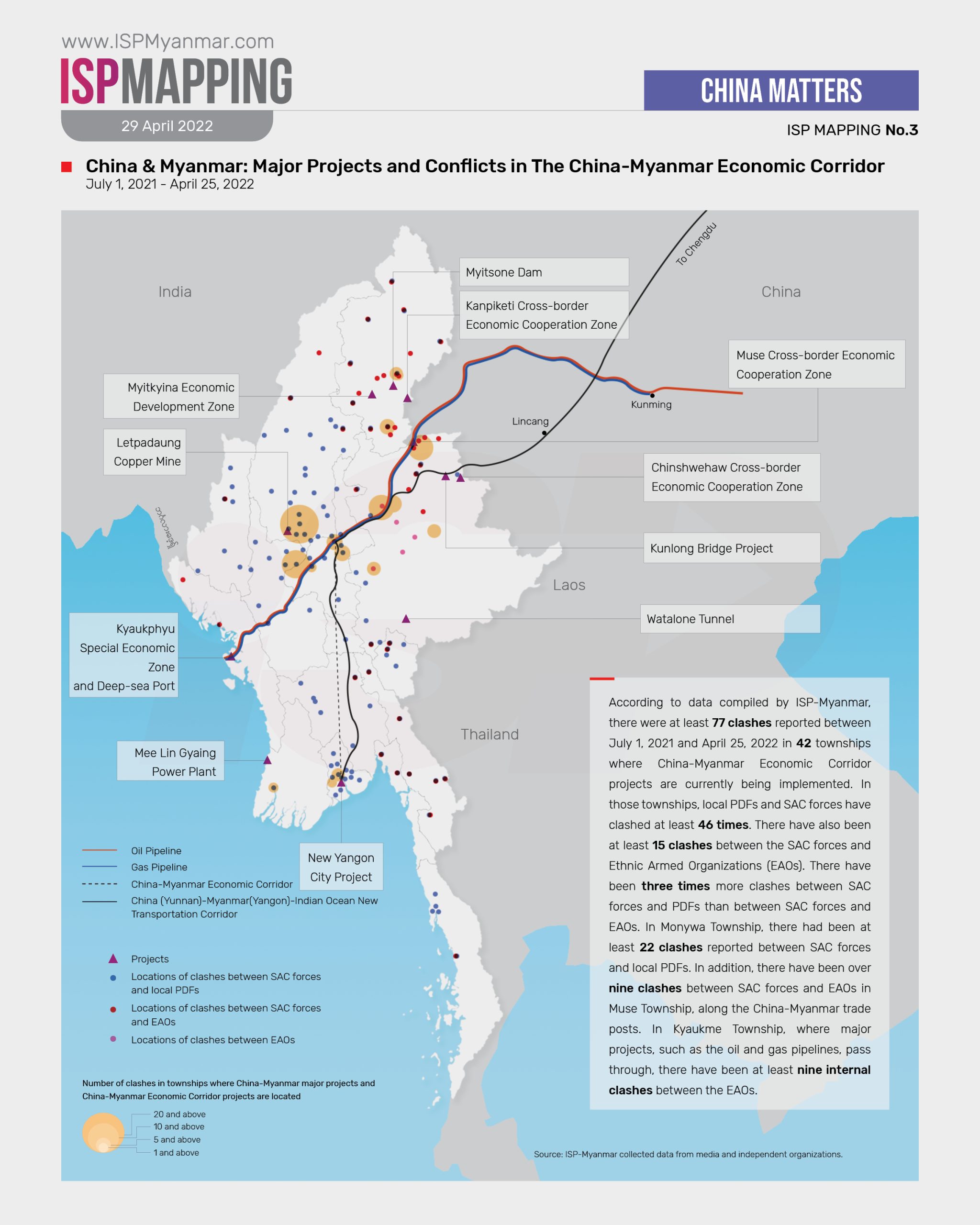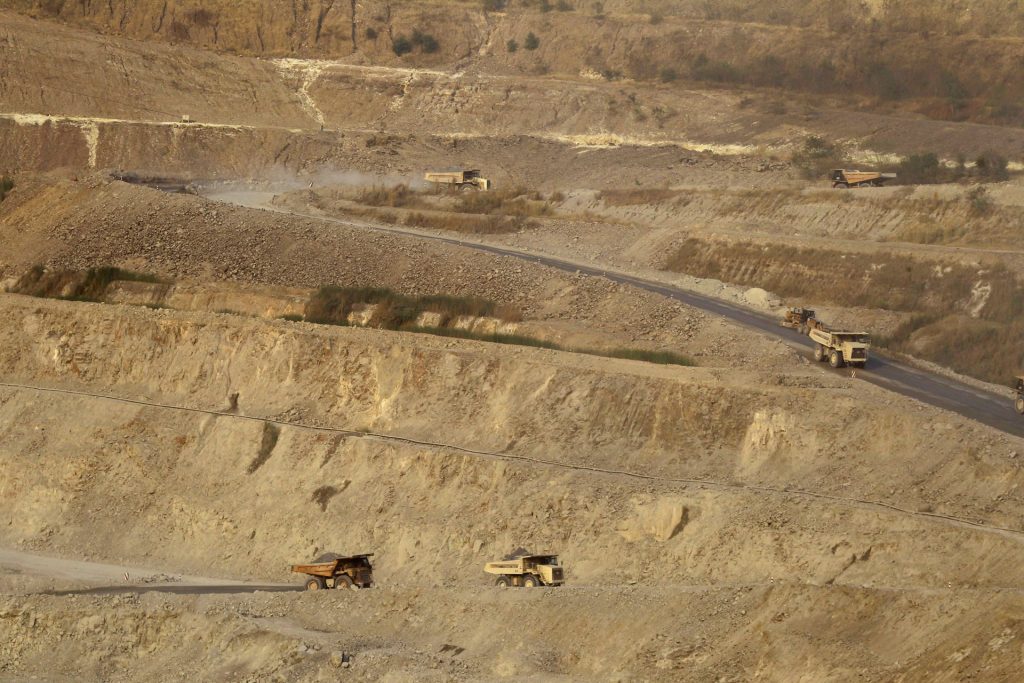ISP Mapping No. 3
(This article is a translation of the Burmese language version that ISP-Myanmar posted on its Facebook page on April 29, 2022).

The majority of strategic projects designed to boost activity in the China-Myanmar Economic Corridor are, currently, going to be implemented in ethnic minority areas where armed conflicts are most frequent. After the military coup, Myanmar’s internal conflict map expanded to incorporate escalating conflicts between State Administration Council (SAC) forces and Ethnic Armed Organizations (EAOs), as well as the burgeoning conflict between the newly formed local defense forces and SAC forces. Local People’s Defense Forces (PDFs) have also strengthened their forces in townships where the China-backed Letpadaung Copper Mine and the Tagaung Nickel-Processing Plant are located.
On April 1, Chinese Foreign Minister Wang Yi and SAC’s Foreign Minister Wunna Maung Lwin met during a diplomatic visit after an official invitation from the Chinese government. During the meeting, China said it would always support Myanmar in safeguarding its national sovereignty. The SAC also reported that the two countries had a discussion in which China will support Myanmar with 650 million Yuan to boost cross-border trade, economy and to continue the implementation of Chinese and Chinese-backed projects. Two weeks after the announcement, 16 local PDFs issued a warning that the China-backed copper projects in Sagaing Region, which are cooperating with the SAC, will be sabotaged and attacked if they continue their operations. Further to this, 558 Myanmar civil society groups also sent an open letter to Chinese President Xi Jinping on April 25, stating that, if China continues to work with the SAC and implement new economic projects, the projects could become a military target for the PDFs and face major losses. Despite the warnings, the clashes near Chinese-backed economic projects have yet to have any major impact.
∎ Attacks on Major China-Myanmar Projects
On February 14, 2022, a PDF opened fire on SAC forces guarding the China-Myanmar gas pipeline control plant in the Mandalay Region’s Natogyi Township. After the attack, the PDF issued a statement, claiming that the attack was not targeting the pipeline. Moreover, on February 20, 2022, the Wanbao Mining Company’s Letpadaung Project site in Sagaing Region’s Salingyi Township was attacked with rocket fire, according to a statement by the Monywa Red Fire PDF. The statement added that the attack was intended as a warning shot to deter SAC forces from aiming heavy artillery towards the villages of Monywa and Nyaungbingyi.
According to data compiled by ISP-Myanmar, there were at least 77 clashes reported between July 1, 2021 and April 25, 2022 in 42 townships where China-Myanmar Economic Corridor projects are currently being implemented. Of that total, 34 clashes occurred between February 4 and April 25, 2022. Local PDFs and SAC forces have clashed at least 46 times in the townships with ongoing China-Myanmar economic projects. There have also been at least 15 clashes between the SAC forces and ethnic minority armed groups (EAOs). There have been three times more clashes between SAC forces and PDFs than between SAC forces and EAOs. Additionally, there have also been 16 internal clashes within the EAOs themselves. In Monywa Township, there had been at least 22 clashes reported between SAC forces and local PDFs. In addition, there have been at least nine clashes between SAC forces and EAOs in Muse Township, along the China-Myanmar trade posts. In Kyaukme Township, where major projects, such as the oil and gas pipeline pass through, there have been at least nine internal clashes between the EAOs. The exact number of these clashes can be observed in the map below.
∎ Why does it matter?
It is clear that the fighting that took place after the military coup, which involved the targeting of major Chinese projects could have a major impact on China’s general and economic policy considerations for Myanmar; China’s response may vary depending on the emerging resistance forces, such as the PDFs, within Myanmar. It is particularly important to observe the military operations of the EAOs in Shan State, the focal point of Chinese economic and infrastructure projects, and especially the situation along the China-Myanmar Economic Corridor. It is important to note whether the EAOs are trying to preserve territorial integrity and military advantage in order to expand China’s influence or to guarantee the security of Chinese ventures. Additionally, it is also important to study the response of emerging local defense forces towards Chinese economic interests across the country, as China’s policy on Myanmar could change.
∎ Other relevant readings
The post-coup conflict situation in Myanmar, relating specifically to major China-Myanmar projects can be observed in the on-the-ground reports from independent media groups, ethnic minority news organizations, press releases from the Chinese Embassy, Chinese media outlets and reports from other independent local and foreign organizations.

